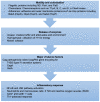Inflammation and Gastric Cancer
- PMID: 35892729
- PMCID: PMC9326573
- DOI: 10.3390/diseases10030035
Inflammation and Gastric Cancer
Abstract
Gastric cancer remains a major killer globally, although its incidence has declined over the past century. It is the fifth most common cancer and the third most common reason for cancer-related deaths worldwide. Gastric cancer is the outcome of a complex interaction between environmental, host genetic, and microbial factors. There is significant evidence supporting the association between chronic inflammation and the onset of cancer. This association is particularly robust for gastrointestinal cancers in which microbial pathogens are responsible for the chronic inflammation that can be a triggering factor for the onset of those cancers. Helicobacter pylori is the most prominent example since it is the most widespread infection, affecting nearly half of the world's population. It is well-known to be responsible for inducing chronic gastric inflammation progressing to atrophy, metaplasia, dysplasia, and eventually, gastric cancer. This review provides an overview of the association of the factors playing a role in chronic inflammation; the bacterial characteristics which are responsible for the colonization, persistence in the stomach, and triggering of inflammation; the microbiome involved in the chronic inflammation process; and the host factors that have a role in determining whether gastritis progresses to gastric cancer. Understanding these interconnections may improve our ability to prevent gastric cancer development and enhance our understanding of existing cases.
Keywords: H. pylori; environmental factors; gastric cancer; gastric microbiome; immunity; inflammation.
Conflict of interest statement
The authors declare no conflict of interest.
Figures
References
Publication types
LinkOut - more resources
Full Text Sources
Miscellaneous





